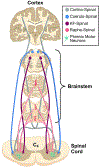The phrenic neuromuscular system
- PMID: 35965035
- PMCID: PMC11135908
- DOI: 10.1016/B978-0-323-91534-2.00012-6
The phrenic neuromuscular system
Abstract
The phrenic neuromuscular system consists of the phrenic motor nucleus in the mid-cervical spinal cord, the phrenic nerve, and the diaphragm muscle. This motor system helps sustain breathing throughout life, while also contributing to posture, coughing, swallowing, and speaking. The phrenic nerve contains primarily efferent phrenic axons and afferent axons from diaphragm sensory receptors but is also a conduit for autonomic fibers. On a breath-by-breath basis, rhythmic (inspiratory) depolarization of phrenic motoneurons occurs due to excitatory bulbospinal synaptic pathways. Further, a complex propriospinal network innervates phrenic motoneurons and may serve to coordinate postural, locomotor, and respiratory movements. The phrenic neuromuscular system is impacted in a wide range of neuromuscular diseases and injuries. Contemporary research is focused on understanding how neuromuscular plasticity occurs in the phrenic neuromuscular system and using this information to optimize treatments and rehabilitation strategies to improve breathing and related behaviors.
Keywords: Breathing; Diaphragm; Interneuron; Motoneuron; Phrenic; Spinal.
Copyright © 2022 Elsevier B.V. All rights reserved.
Figures







References
-
- Alilain WJ & Goshgarian HG (2008). Glutamate receptor plasticity and activity-regulated cytoskeletal associated protein regulation in the phrenic motor nucleus may mediate spontaneous recovery of the hemidiaphragm following chronic cervical spinal cord injury. Exp Neurol 212: 348–357. - PMC - PubMed
-
- Allan DW & Greer JJ (1997). Embryogenesis of the phrenic nerve and diaphragm in the fetal rat. J Comp Neurol 382: 459–468. - PubMed
-
- An X, Yue B, Lee JH, et al. (2012). Intramuscular distribution of the phrenic nerve in human diaphragm as shown by Sihler staining. Muscle Nerve 45: 522–526. - PubMed
-
- Bains KNS, Kashyap S & Lappin SL (2021). Anatomy, Thorax, Diaphragm. StatPearls. Treasure Island (FL). - PubMed
Publication types
MeSH terms
Grants and funding
LinkOut - more resources
Full Text Sources

